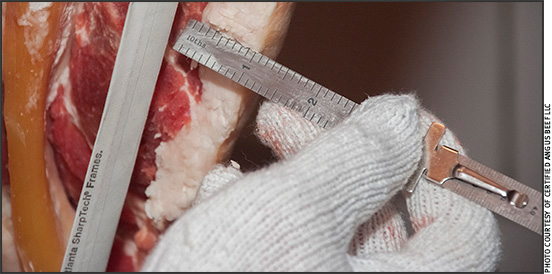
Do We Need a New YG Formula?
Economist looks at the beef yield-grading system, its history, current status and future.
The beef carcass yield-grading system used in the United States may not be completely broken, but it surely doesn’t work very well. That was the opinion that West Texas A&M University animal scientist Ty Lawrence offered during the 2016 Beef Improvement Federation Annual Meeting and Symposium hosted June 14-17 in Manhattan, Kan. Speaking before the Advancements in End Product Improvement breakout session, Lawrence called USDA’s method for determining beef yield grades “an antiquated system based on antiquated cattle.”
Sharing the history of its development and adoption, Lawrence said the yield-grading system is rooted in the 1950s. He explained how it was derived from data collected from just 162 beef carcasses representative of the period. Read more.

Radale Tiner
Association Perspective
The power of recordkeeping.
Keeping accurate records in a commercial herd is the best way to advance your herd. Without keeping written records, many times it is difficult to know which cows are the most efficient in their production and performance.
I encourage you to keep records of which cows are having a calf every 365 days and to individually weigh each calf to know which cow is bringing the most pounds to the weaning pens. Once you start keeping and/or culling cows based on this data, you will soon realize that your herd is more efficient. It has been my experience that ranchers become partial to certain cows and make themselves believe that a particular cow is performing well, while not having any documentation to prove this data. Once they have written data, they usually soon realize that they are incorrect in their assumptions. Read more.
Opportunity in Management
Tips for making the cow herd more efficient and more profitable by 2036.
Who would have thought five years ago that cow-calf producers would see calf prices at $275 per hundredweight (cwt.) at the same time that oil was priced at $30 per barrel? It’s evidence that no one can predict the future.
“We can watch for trends, though,” said Clay Mathis, Texas A&M professor and director of the King Ranch Institute for Ranch Management, during the 2016 Beef Improvement Federation (BIF) Annual Meeting and Symposium hosted June 14-17 in Manhattan, Kan. “We should try to prepare for what’s likely to happen — create a scenario for the future,” he advised the audience. Read more.
Tackling the Cattle Fever Tick with Vaccine
New vaccine announced to help combat disease.
The Texas Animal Health Commission (TAHC) is proud to announce the arrival of a new tool in fever tick eradication efforts. The new fever tick vaccine will be a valuable tool for reducing the risk of new fever tick infestations in quarantine areas such as the tick eradication quarantine area, or permanent quarantine zone, and in temporary preventative or control quarantine areas.
After more than five years of cooperative research and development between the USDA Agricultural Research Service (ARS) and Veterinary Services (VS) and Zoetis, the first doses of the vaccine were delivered to TAHC on May 17. Plans are under way to host producer meetings in the counties along the permanent quarantine zone to provide information on the effectiveness and use of the vaccine and to provide producers the opportunity to ask questions. The dates of these meetings will be set in the coming weeks. Read more.
What’s Inside …
In this June edition of the Angus Beef Bulletin EXTRA, you'll find valuable articles devoted to the management, marketing, and health and nutrition of your beef enterprise. Select from the tabs at the top of the page to access this month’s entire offering by category. A few select features include:
- $Values to Shift Due to Market Trends
- On Target: Cow size
- Pain Management Update
- Managing Heat Stress
- New Mitigation Option for Heat Stress
- Breakaway Demand
- Compromised Cows
News Briefs …
The American Angus Association and its subsidiaries generate a wealth of information to keep members and affiliates informed of what's happening within the industry, as well as with the programs and services they offer. Click here for easy access to the newsrooms of the American Angus Association and Certified Angus Beef LLC and the Angus Journal Daily archive available in the API Virtual Library.
Be Safe:
Animal Control Tips for Livestock Producers
Keep safety of both cattle and producers in mind when handling animals.
Livestock producers need to take precautions and be prepared to implement safety procedures when having visitors or tours on their farm or when exhibiting animals, to prevent risk of injury to both humans and animals, says a beef cattle expert with the College of Food, Agricultural and Environmental Sciences at the Ohio State University (OSU).
That’s especially true when visitors to farms or other livestock exhibits don’t have a background in production agriculture and have little understanding of the process of food production, said John Grimes, beef coordinator for OSU Extension and a member of the OSU Extension Beef Team. Read more.
![]()
Lock and Key
Understanding lock for cellular trap door may lead to better disease treatment.
A team of researchers who two years ago announced a “Trojan horse” method of entering a cell without harming it have now found, in effect, the lock to the cellular “trap door.” The research, led by Jean-Philippe Pellois, appears in the May 5 issue of the journal Cell Chemical Biology.
“We had the key to the cell from the previous research, and now we understand the lock,” said Pellois, a Texas A&M AgriLife Research biochemist in College Station. Read more.






